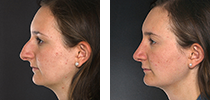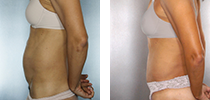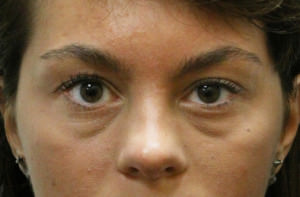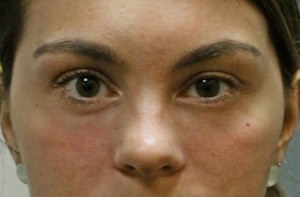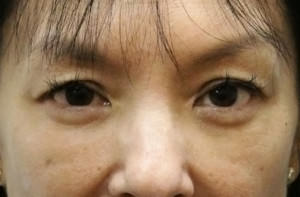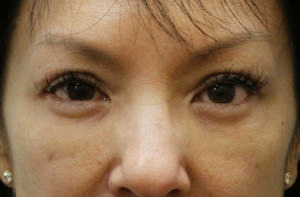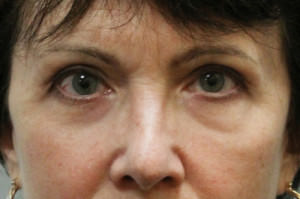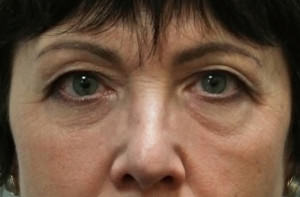Blepharoplasty
Conveniently located to serve the areas of New York, NY

Blepharoplasty, also known as eyelid surgery or an eyelid lift, is a transformative procedure that rejuvenates the appearance of the eyes. In the past several years, blepharoplasty has risen to among the top five plastic surgery procedures performed on both men and women in the United States. (1) In just one year, over 175,000 cases were performed in the United States alone. The operation addresses both problems of aging around the eyelids and younger patients who have dark circles or puffy eyelids, which are usually inherited.
At our Plastic Surgery office in New York, we have provided numerous women and men with beautiful results from their blepharoplasty in New York. Dr. Sherman is a board-certified plastic surgeon and one of the most experienced plastic surgeons in New York, with over 40 years in the field. Dr. Sherman specializes in facial rejuvenation and can use his skill and eye for facial aesthetics to ensure your blepharoplasty results look as natural as possible.
Contents
Before and After Photos
About Blepharoplasty
There are several options available for blepharoplasty. The choice depends on the age of the patient, the amount of fat in the upper and lower eyelids, and the general elasticity and tone of the lower eyelid. Dr. Sherman specializes in surgical facial rejuvenation and offers both upper-eyelid surgery and lower-eyelid surgery, also referred to as under-eye bag surgery, for patients in New York City.
Transconjunctival Blepharoplasty
Dr. Sherman has routinely performed transconjunctival blepharoplasty operations over the past 30 years and was featured in an article describing this procedure in Elle magazine. This procedure is ideal for younger patients to those in their early forties who have inherited a family tendency for puffy upper and lower eyelids. It is perfect for the patient who has that puffiness in the upper and lower eyelids. In these younger patients, the fat may be removed without removing skin, because the skin has enough elasticity to contract. On the upper lids, a small amount of skin may be removed.
Transconjunctival Blepharoplasty: The Procedure
In a transconjunctival blepharoplasty, the incision is made inside the eyelid, avoiding any type of scar. The periorbital fat is then carefully and conservatively teased out of the lower eyelid. Because of the elasticity in the younger patient, the skin drapes nicely, avoiding the need for skin adjustment. If a small amount of skin must be tightened, a laser peel or “skin pinch” may be performed simultaneously.
The operation for transconjunctival lower lid blepharoplasty takes roughly 30 minutes. If upper eyelids are added, the procedure may take up to one hour. Most of our patients are back to work within a week, without the use and need for any suturing.
Lower Eyelid Resuspension or Canthopexy
In older patients, the eyelid is lax: It has lost its elasticity. In these patients, the lower eyelid may need to be repositioned or tightened. This is due to aging and poor tone. The patient often notices that too much sclera (white of the eye) shows below the iris (the colored part of the eye). This procedure restores the natural shape and the tension of the lower eyelid; it is usually performed in conjunction with lower eyelid blepharoplasty and upper eyelid blepharoplasty on older patients if needed.
Laser Resurfacing of the Eyelids
This procedure has the advantage of resurfacing the eyelids to provide a younger fresher look, and to minimize the finer wrinkling that is often present with aging and/or sun damage. This procedure is also performed as an outpatient and may be performed with blepharoplasty.
Blepharoplasty Candidates
The eyelid procedure is routinely performed on patients from their late adolescence through later years. Younger patients who request this operation often have inherited fat pockets which may appear as dark circles underneath the eyelids. The nature of each procedure varies widely depending on the age and needs of the individual patient.
“Dr. Sherman did my upper and lower eyelids 2 weeks ago. I could not be happier with the experience (very caring, very professional, virtually painless) or with the results. I would recommend him without reservation.”
Blepharoplasty Patient
Personal Consultation

Dr. Sherman’s expertise lies in meticulously examining the skin and underlying structures of your eyelids, evaluating the extent of fat deposits, the condition of your musculature, and the overall quality of your skin. These factors play a crucial role in determining whether you are an ideal candidate for blepharoplasty or if alternative treatments might better suit your needs.
Patients with minimal fat deposits and moderate skin laxity may benefit from a less invasive skin tightening procedure, eliminating the need for more extensive surgery.
Do I Need a Facelift and Blepharoplasty?
Individuals whose skin laxity extends beyond their eyelids to their face may consider combining a facelift with their blepharoplasty for a more comprehensive rejuvenation.
Your consultation with Dr. Sherman is an invaluable opportunity to explore all available options, allowing you to make an informed decision.
Preparation
- Medication Management: As instructed by Dr. Sherman, discontinue any blood thinners, supplements, and medications that may interfere with the surgery or recovery process. This is crucial to minimize the risk of excessive bleeding during and after the procedure.
- Nicotine-Free Environment: If you are a smoker or use nicotine products, it is essential to stop their use in the weeks leading up to your surgery. Nicotine can impair healing and increase the risk of complications. (2) Remaining nicotine-free throughout your recovery period is equally important for optimal results.
- Prescription Fill-Up: Prior to your surgery, make sure to fill any prescriptions for pain medication and antibiotics that our team has provided. Having these medications ready in advance will save you valuable time and ensure a seamless recovery.
- Transportation Arrangements: Depending on the type of anesthesia used for your procedure, you may require assistance getting home safely. Coordinate a ride with a trusted companion who can escort you post-surgery, ensuring your comfort and well-being.
- Allow Ample Rest Time: To promote a speedy recovery, it is essential to arrange time off from work and social commitments. Giving yourself adequate time to rest and heal will support the best possible outcome.
Blepharoplasty Procedure
Upper blepharoplasty or lower blepharoplasty is almost always performed under intravenous sedation anesthesia, supplemented with local anesthesia. Of course, as in all of our surgeries, the patient is continuously monitored by a board-certified anesthesiologist. The patient is drowsy, pain-free, and unaware of the procedure that is being performed.
The operation may take anywhere from 30 minutes to one hour. This depends on whether a four-lid blepharoplasty is performed, or if just the lower eyelids or upper eyelids are done. The patient is then transferred to the recovery room and will be discharged from our clinic approximately one hour after surgery.
Recovery
After discharge, the patient may return home or to the hotel under the care of a nurse, friend, or family member. The main requirement is to maintain an ice compress on the eyelids for several hours after surgery as this will reduce bruising.
How Comfortable is Eyelid Surgery Recovery?

This procedure is usually characterized by patients having minimal discomfort in the postoperative period. Dr. Sherman usually prescribes pain medication. However, the patient will look worse than he or she feels due to the bruising that usually accompanies blepharoplasty. Bruising is typically gone within 10 days of the procedure. Sutures, if present, are removed by the fourth or fifth day. Patients can go out and do normal activities on the first day but usually wear sunglasses to disguise their bruising.
How Long Does Swelling Last After Eyelid Surgery?
Swelling usually lasts up to three weeks, and the final eyelid result is obtained in two months. Scars are placed in inconspicuous areas that are most difficult to see on the upper lid. On the lower eyelid, if a transconjunctival blepharoplasty is not performed, the scar is placed right below the eyelashes, which is most difficult to see. In younger patients when a transconjunctival approach is used, the incision is inside the eyelid, without any visible scar.
Dr. Sherman will discuss all potential complications and the relative frequency (or infrequency) of their occurrences. This may include bleeding, dry eye, and swelling.
Cost of Eyelid Surgery in New York City
The cost of your blepharoplasty will be determined by several factors including the type of blepharoplasty performed, and the amount of work required to attain your desired results. During your initial consultation, Dr. Sherman can let you know what the expected cost of your blepharoplasty will be and let you know about the payment options available to you. We do offer financing options to help make the payment process easier.
Contact our plastic surgery and cosmetic surgery center in New York City at (212) 535-2300
to schedule a consultation for your blepharoplasty with Dr. Sherman.
FAQ
What type of anesthesia is used in eyelid surgery?
The procedure is usually performed under sedation anesthesia in the office setting. Our office is fully accredited, and anesthesia is administered by an experienced board-certified anesthesiologist.
How can I get rid of excess eyelid skin?
Excess skin on the eyelids can make you look older and even impair your vision. Eyelid surgery addresses this concern by removing the surplus skin, resulting in a smoother and more youthful eyelid contour. By eliminating the excess skin, you can achieve a more rejuvenated and refreshed appearance.
What is eyelid ptosis?
Eyelid ptosis refers to the drooping or sagging of the upper eyelid due to weakened or stretched muscles. Eyelid surgery can correct this condition by tightening the muscles responsible for lifting the eyelids, resulting in a more youthful and alert appearance. This procedure not only enhances your aesthetic but can also improve your vision and overall quality of life.
References
- Miotti G, Zeppieri M, Pederzani G, Salati C, Parodi PC. Modern blepharoplasty: From bench to bedside. World Journal of Clinical Cases. 2023;11(8):1719-1729. doi:https://doi.org/10.12998/wjcc.v11.i8.1719
- McDaniel JC, Browning KK. Smoking, Chronic Wound Healing, and Implications for Evidence-Based Practice. Journal of Wound, Ostomy and Continence Nursing. 2014;41(5):415-423. doi:https://doi.org/10.1097/won.0000000000000057


